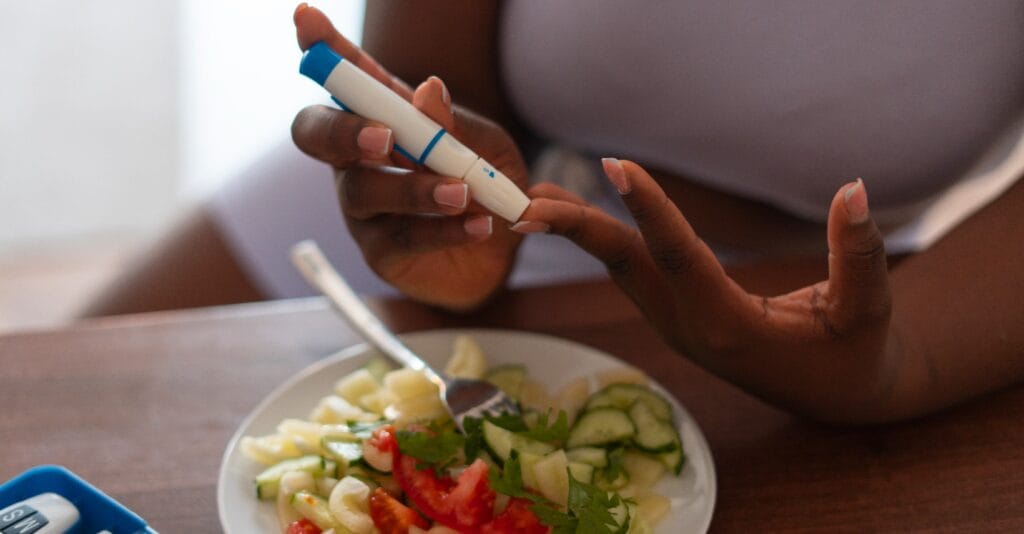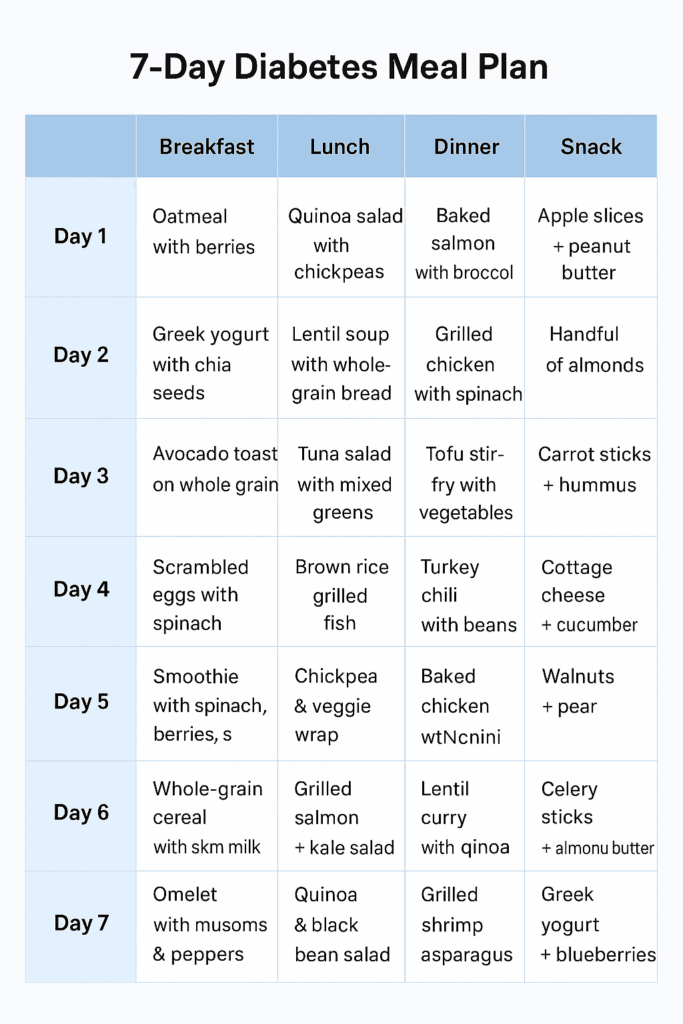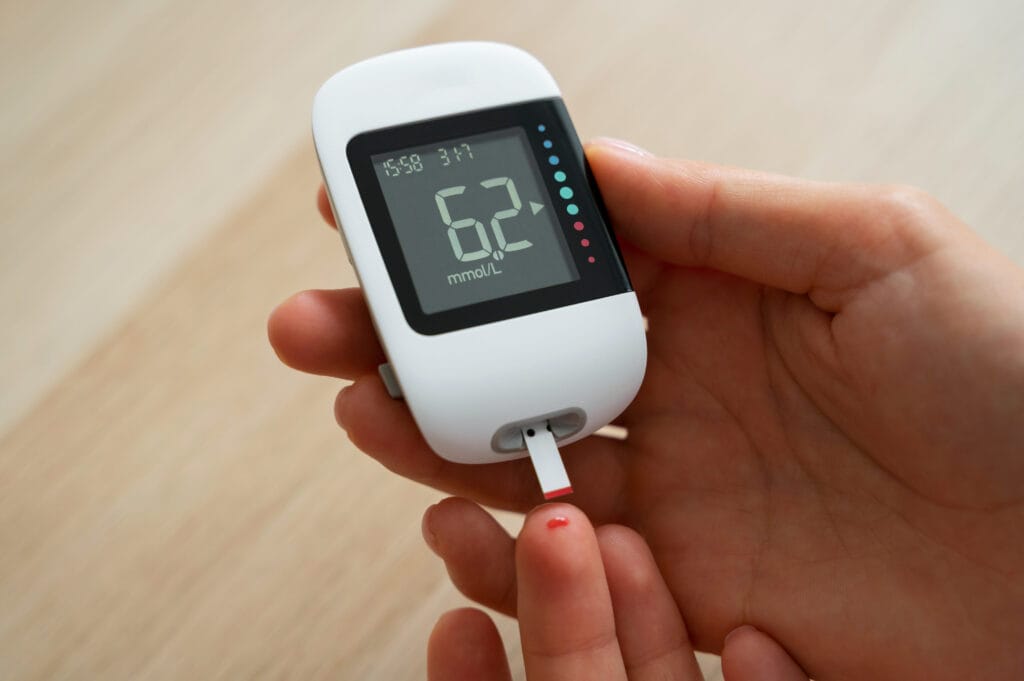
Living with diabetes doesn’t mean giving up the foods you love, it means making smarter choices to keep your blood sugar stable, feel energized, and protect your long-term health. Whether you’re in the United States, United Kingdom, or Australia, this guide, crafted with insights from medical research and clinical experience, offers clear, practical advice on eating well to manage diabetes effectively. This guide draws from trusted sources like the American Diabetes Association guidelines and studies in Diabetes Care to help you understand what to eat, what to avoid, and how to thrive with diabetes.
Why a Healthy Diet Matters for Diabetes Patients
A well-planned diet is one of the most powerful tools for managing diabetes. It helps control blood sugar, supports a healthy weight, and lowers the risk of complications like heart disease or nerve damage. Eating the right foods can make you feel better day-to-day, reduce your reliance on medications, and improve your overall quality of life. Here’s why nutrition is so important:
- Steady Blood Sugar: Choosing foods that release sugar slowly prevents sudden spikes that can harm your body over time.
- Better Energy: Nutrient-rich meals keep you energized without the crashes caused by sugary or processed foods.
- Heart Health: Diabetes raises the risk of heart problems, so a diet low in unhealthy fats and high in fiber protects your heart.
- Weight Control: A balanced diet helps maintain a healthy weight, which improves how your body uses insulin.
What a Healthy Diabetes Diet Looks Like
A healthy diet for diabetes focuses on whole, natural foods that provide steady energy and essential nutrients. It’s not about strict rules but about balance, portion control, and choosing foods that work with your body. Below, we explain the key parts of a diabetes-friendly diet and why poor eating habits can cause problems, with real-life examples from patients.
Key Parts of a Diabetes Diet
- Whole Grains: Choose grains like quinoa, brown rice, or oats instead of white bread or pasta. These release energy slowly, keeping blood sugar stable.Example: Swap white rice for brown rice in your favorite stir-fry.
- Non-Starchy Vegetables: Fill your plate with vegetables like spinach, broccoli, or zucchini. They’re low in calories and packed with vitamins.Example: Roast broccoli with a drizzle of olive oil for a tasty side.
- Lean ProteinsInclude: fish, chicken, eggs, or plant-based options like lentils or tofu. These help you stay full and support muscle health.Example: Grill salmon for a heart-healthy dinner.
- Healthy Fats: Use olive oil, avocados, or nuts instead of butter or fried foods. These fats support your heart without raising blood sugar.Example: Add a handful of almonds to your morning yogurt.
- Low-Sugar Fruits: Berries, apples, or pears are great choices. They’re sweet but won’t spike your blood sugar when eaten in moderation.Example: Pair a small apple with peanut butter for a balanced snack.
Risks of Unhealthy Eating
Eating too many sugary, fatty, or processed foods can make diabetes harder to manage and lead to serious health issues:
- Blood Sugar Spikes: Sugary drinks or white bread cause rapid glucose spikes, which can damage blood vessels and nerves.
- Weight Gain: Extra calories from fast food or sweets make it harder for your body to use insulin properly.
- Heart Problems: High-fat, high-sodium foods increase the risk of heart attacks or strokes, which are more common in diabetes.
- Low Energy: Poor food choices can leave you tired and moody, making daily tasks harder.
Real-Life Patient Stories
- Emma, 42, Type 2 Diabetes, Emma loved soda and fast food, but her blood sugar was out of control, and she felt tired all the time. After switching to a diet of vegetables, lean chicken, and quinoa, she lost 15 pounds, her energy soared, and her doctor reduced her medication.
- Jane, 58, Type 2 Diabetes, James ate a lot of white bread and sugary snacks, causing his blood sugar to stay high. He started eating oats for breakfast and lentils for lunch, which helped him keep his blood sugar steady and feel more active.
- Sophie, 36, Gestational Diabetes. During pregnancy, Sophie struggled with cravings for sweets. By eating low-sugar fruits like berries and small portions of whole grains, she kept her blood sugar in check and had a healthy baby.
Your Guide to Eating Well with Diabetes
A diabetes-friendly diet is all about balance and variety. Below, we break down how to build your plate, what to eat, and how much of each nutrient you need.
The Diabetes Plate Method
This simple method helps you create balanced meals without complicated calculations:
- Half Your Plate: Non-Starchy VegetablesFill half your plate with veggies like leafy greens, cauliflower, or peppers. These are low in carbs and high in fiber, keeping you full without raising blood sugar.Example: Try a colorful salad with spinach, tomatoes, and cucumbers.
- Quarter of Your Plate: Lean ProteinChoose proteins like grilled fish, chicken, or beans. These keep you satisfied and support muscle health.Example: Add chickpeas to your salad or bake chicken for dinner.
- Quarter of Your Plate: Whole Grains or Starchy VegetablesPick whole grains like barley or starchy veggies like sweet potatoes. These provide energy without big blood sugar spikes.Example: Pair a small sweet potato with your meal.
- Drinks: Stick to water, unsweetened tea, or black coffee. Avoid sugary sodas or juices.
Nutrient Guidelines
- Carbohydrates: Focus on quality, not just quantity. Choose whole grains or starchy vegetables for most meals, aiming for small, controlled portions (e.g., ½ cup of quinoa per meal).
- Protein: Include a source of protein in every meal, like eggs or tofu, to stay full and support your muscles.
- Fats: Use healthy fats like olive oil or nuts in moderation. Avoid fried foods or processed snacks with unhealthy fats.
- Fiber: Eat plenty of fiber-rich foods like vegetables and legumes to help digestion and blood sugar control.
Meal Timing Tips
- Eat Regularly: Have three meals and one or two small snacks daily to keep blood sugar steady.
- Bigger Breakfast, Smaller Dinner: Eating more earlier in the day helps your body process carbs better.
- Space Out Carbs: Spread carbs evenly across meals to avoid blood sugar spikes.
Seven day meal plan for diabetis
A 7-day diabetes meal plan provides structure, balance, and consistency, which are essential for managing blood sugar effectively. By organizing meals across the week, it helps control portion sizes, ensures steady energy, and supports heart health. This approach not only prevents glucose spikes and crashes but also encourages long-term healthy eating habits, making it easier to enjoy food while protecting overall health. Check the sample table below
7-Day Diabetes Meal Plan

Best Foods for Diabetes
Here’s a detailed list of foods to include, with ideas for meals that work in American, British, and Australian diets.
Recommended Foods
- Whole Grains
- Options: Quinoa, barley, oats, whole-grain bread.
- Why: These release sugar slowly, keeping blood sugar steady.
- Idea: Make a quinoa salad with veggies and chickpeas for lunch.
- Non-Starchy Vegetables
- Options: Kale, broccoli, zucchini, asparagus.
- Why: Low in carbs and packed with nutrients to support health.
- Idea: Stir-fry zucchini and peppers with olive oil for a quick side.
3. Fruits
- Options: Blueberries, apples, pears, grapefruit.
- Why: Provide natural sweetness with fiber to slow sugar absorption.
- Idea: Snack on berries with a handful of walnuts.
4. Legumes
- Options: Lentils, black beans, chickpeas.
- Why: High in protein and fiber, great for blood sugar and fullness.
- Idea: Add lentils to a vegetable soup for a hearty meal.
5. Nuts and Seeds
- Options: Almonds, walnuts, chia seeds, flaxseeds.
- Why: Offer healthy fats and protein to keep you satisfied.
- Idea: Sprinkle chia seeds on oatmeal or yogurt.
6. Herbs and Spices
- Options: Cinnamon, turmeric, garlic.
- Why: Add flavor without sugar or sodium; some may help blood sugar control.
- Idea: Use cinnamon in oatmeal or turmeric in soups.
Meal Ideas for American, British, and Australian Diets
- American-Inspired
- Grilled Salmon with Quinoa and Asparagus: A heart-healthy meal with lean protein and whole grains.
- Black Bean Salad: Mix black beans, tomatoes, avocado, and lime juice for a fresh, diabetes-friendly dish.
- British-Inspired
- Lentil and Vegetable Soup: A comforting, fiber-rich soup perfect for cooler days.
- Baked Chicken with Roasted Root Vegetables: Use sweet potatoes and parsnips for a balanced meal.
- Australian-Inspired
- Barramundi with Veggie Stir-Fry: Pair this local fish with broccoli and peppers for a low-carb dish.
- Quinoa Porridge with Berries: A nutrient-packed breakfast option.
Foods to Avoid
Some foods can make diabetes harder to manage and increase health risks. Limit or avoid:
- Sugary Drinks: Soda, sweetened tea, or energy drinks cause quick blood sugar spikes.
- Refined Carbs: White bread, pastries, or white rice digest too fast, raising glucose levels.
- Fried Foods: Fast food or fried snacks contain unhealthy fats that harm your heart.
- Sweets: Candy, cakes, or ice cream should be rare treats; opt for fruit instead.
- High-Sodium Foods: Canned soups or processed meats can raise blood pressure.
Frequently Asked Questions
- Can I eat fruit if I have diabetes?
A: Yes, but choose low-sugar fruits like berries, apples, or pears, and stick to small portions (e.g., one small apple). Pair with protein or nuts to slow sugar absorption. - How often should I eat to manage blood sugar?
A: Aim for three balanced meals and one or two small snacks daily. Eating every 3–4 hours helps keep blood sugar steady. - Are low-carb diets best for diabetes?
A: Low-carb diets can help, but balance is key. Focus on whole grains and vegetables for carbs, and work with a doctor or dietitian to find what suits you. - Can I have desserts?
A: Occasionally, yes, but choose small portions of desserts made with natural sweeteners like fruit or stevia, and avoid processed sugary treats. - How do I know if my diet is working?
A: Monitor your blood sugar with a glucometer or continuous glucose monitor (CGM), and check your HbA1c with your doctor every 3–6 months.
Empowering Your Diabetes Journey
Managing diabetes through diet is about making sustainable, enjoyable choices that support your health and happiness. By focusing on whole grains, vegetables, lean proteins, and healthy fats, you can stabilize your blood sugar, boost your energy, and reduce the risk of complications. This isn’t about deprivation, it’s about finding delicious, nutrient-packed foods that work for your body and lifestyle. Pair your diet with regular exercise, stress management, and routine doctor visits to stay on top of your health.
As Dr. Zara, I encourage you to take small, consistent steps toward better eating habits. Every healthy choice is a step toward a vibrant life with diabetes. If you have questions or need personalized advice, feel free to reach out to me at Drzaramulla@gmail.com. I’m here to help you navigate your unique diabetes journey with confidence.
Top Links
https://www.virtua.org/articles/the-top-10-foods-for-a-healthy-diabetes-diet
https://medlineplus.gov/diabeticdiet.html
https://www.nanavatimaxhospital.org/blogs/diet-chart-for-diabetic-patients

